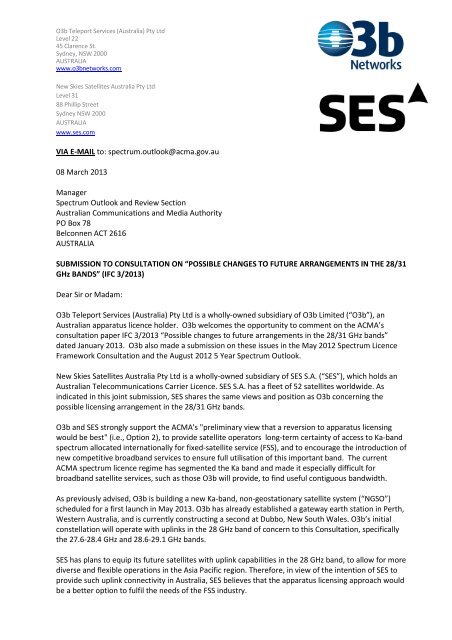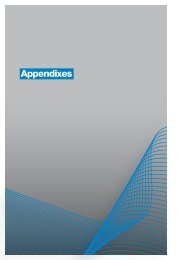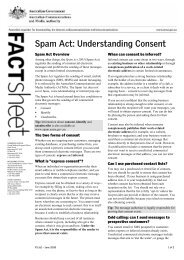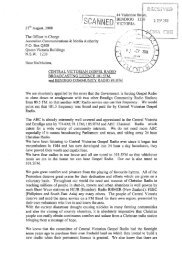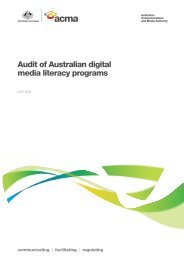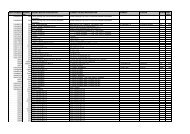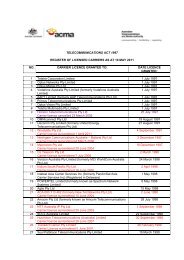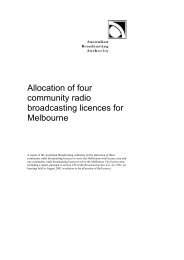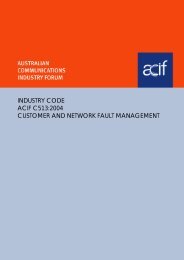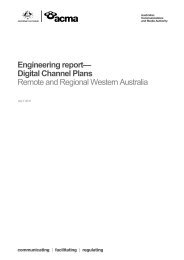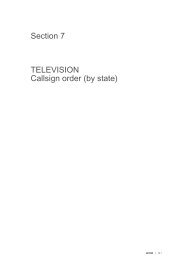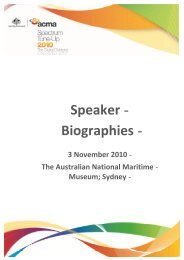O3B Networks and New Skies Satellites Australia - ACMA
O3B Networks and New Skies Satellites Australia - ACMA
O3B Networks and New Skies Satellites Australia - ACMA
You also want an ePaper? Increase the reach of your titles
YUMPU automatically turns print PDFs into web optimized ePapers that Google loves.
O3b Teleport Services (<strong>Australia</strong>) Pty Ltd<br />
Level 22<br />
45 Clarence St.<br />
Sydney, NSW 2000<br />
AUSTRALIA<br />
www.o3bnetworks.com<br />
<strong>New</strong> <strong>Skies</strong> <strong>Satellites</strong> <strong>Australia</strong> Pty Ltd<br />
Level 31<br />
88 Phillip Street<br />
Sydney NSW 2000<br />
AUSTRALIA<br />
www.ses.com<br />
VIA E-MAIL to: spectrum.outlook@acma.gov.au<br />
08 March 2013<br />
Manager<br />
Spectrum Outlook <strong>and</strong> Review Section<br />
<strong>Australia</strong>n Communications <strong>and</strong> Media Authority<br />
PO Box 78<br />
Belconnen ACT 2616<br />
AUSTRALIA<br />
SUBMISSION TO CONSULTATION ON “POSSIBLE CHANGES TO FUTURE ARRANGEMENTS IN THE 28/31<br />
GHz BANDS” (IFC 3/2013)<br />
Dear Sir or Madam:<br />
O3b Teleport Services (<strong>Australia</strong>) Pty Ltd is a wholly-owned subsidiary of O3b Limited (“O3b”), an<br />
<strong>Australia</strong>n apparatus licence holder. O3b welcomes the opportunity to comment on the <strong>ACMA</strong>’s<br />
consultation paper IFC 3/2013 “Possible changes to future arrangements in the 28/31 GHz b<strong>and</strong>s”<br />
dated January 2013. O3b also made a submission on these issues in the May 2012 Spectrum Licence<br />
Framework Consultation <strong>and</strong> the August 2012 5 Year Spectrum Outlook.<br />
<strong>New</strong> <strong>Skies</strong> <strong>Satellites</strong> <strong>Australia</strong> Pty Ltd is a wholly-owned subsidiary of SES S.A. (“SES”), which holds an<br />
<strong>Australia</strong>n Telecommunications Carrier Licence. SES S.A. has a fleet of 52 satellites worldwide. As<br />
indicated in this joint submission, SES shares the same views <strong>and</strong> position as O3b concerning the<br />
possible licensing arrangement in the 28/31 GHz b<strong>and</strong>s.<br />
O3b <strong>and</strong> SES strongly support the <strong>ACMA</strong>'s "preliminary view that a reversion to apparatus licensing<br />
would be best" (i.e., Option 2), to provide satellite operators long-term certainty of access to Ka-b<strong>and</strong><br />
spectrum allocated internationally for fixed-satellite service (FSS), <strong>and</strong> to encourage the introduction of<br />
new competitive broadb<strong>and</strong> services to ensure full utilisation of this important b<strong>and</strong>. The current<br />
<strong>ACMA</strong> spectrum licence regime has segmented the Ka b<strong>and</strong> <strong>and</strong> made it especially difficult for<br />
broadb<strong>and</strong> satellite services, such as those O3b will provide, to find useful contiguous b<strong>and</strong>width.<br />
As previously advised, O3b is building a new Ka-b<strong>and</strong>, non-geostationary satellite system (“NGSO”)<br />
scheduled for a first launch in May 2013. O3b has already established a gateway earth station in Perth,<br />
Western <strong>Australia</strong>, <strong>and</strong> is currently constructing a second at Dubbo, <strong>New</strong> South Wales. O3b’s initial<br />
constellation will operate with uplinks in the 28 GHz b<strong>and</strong> of concern to this Consultation, specifically<br />
the 27.6-28.4 GHz <strong>and</strong> 28.6-29.1 GHz b<strong>and</strong>s.<br />
SES has plans to equip its future satellites with uplink capabilities in the 28 GHz b<strong>and</strong>, to allow for more<br />
diverse <strong>and</strong> flexible operations in the Asia Pacific region. Therefore, in view of the intention of SES to<br />
provide such uplink connectivity in <strong>Australia</strong>, SES believes that the apparatus licensing approach would<br />
be a better option to fulfil the needs of the FSS industry.
O3b <strong>and</strong> SES provide comments below on each of the discussion points in this Consultation.<br />
Discussion point 1<br />
The <strong>ACMA</strong> invites stakeholder feedback on its preliminary view that the 28/31 GHz b<strong>and</strong>s are currently<br />
underutilised.<br />
O3b <strong>and</strong> SES agree that the 28/31 GHz b<strong>and</strong>s are currently under-utilised in <strong>Australia</strong>. A contributing<br />
factor to this under-utilisation is the b<strong>and</strong> segmentation in <strong>Australia</strong> in the 28 GHz part of the<br />
internationally-allocated Ka-b<strong>and</strong>. This segmentation had the perverse effect of keeping fallow<br />
spectrum that was intended to support wide-scale deployment of terrestrial LMDS services. When<br />
LMDS did not develop as expected, the segmentation prevented other services (most notably satellitebased<br />
ones) from making efficient use of the broader spectrum, <strong>and</strong> bringing innovative services to the<br />
<strong>Australia</strong>n public.<br />
Discussion point 2<br />
The <strong>ACMA</strong> invites stakeholder views on future anticipated use of the b<strong>and</strong>s. In particular, information<br />
on any emerging services in the b<strong>and</strong>s that the <strong>ACMA</strong> has not identified would greatly assist in its<br />
consideration of appropriate future arrangements in the b<strong>and</strong>s.<br />
As a Stakeholder, O3b anticipates that it will make significant use of the28 GHz b<strong>and</strong>s in the future. In<br />
fact, O3b intends to provide both gateway <strong>and</strong> customer broadb<strong>and</strong> services throughout the 27.6-28.4<br />
GHz <strong>and</strong> 28.6-29.1 GHz b<strong>and</strong>s in <strong>Australia</strong> following the launch of its initial satellites, scheduled for May<br />
2013 (with a second launch currently scheduled in August 2013). O3b’s customer channels could be as<br />
wide as 216 MHz in each direction. O3b has already established a 28 GHz Ka-b<strong>and</strong> gateway earth<br />
station in Perth, Western <strong>Australia</strong>, <strong>and</strong> is currently constructing a second at Dubbo, <strong>New</strong> South Wales.<br />
In addition, O3b notes that <strong>Australia</strong> has a large number of Ka-b<strong>and</strong> satellite network filings at various<br />
stages of notification, <strong>and</strong> that NBNCo has announced plans for several Ka-b<strong>and</strong> earth stations in<br />
<strong>Australia</strong> for its own Ka-b<strong>and</strong> broadb<strong>and</strong> satellite services in <strong>Australia</strong>.<br />
Furthermore, due to the congestion currently experienced in the C- <strong>and</strong> Ku-b<strong>and</strong>s, more satellite<br />
operators are looking into the higher frequencies to deploy their services. Since the 28 GHz b<strong>and</strong> is<br />
allocated for FSS in accordance with the ITU Radio Regulations, SES <strong>and</strong> O3b are of the view that there<br />
will be an increased use of this b<strong>and</strong> for satellite services in the near future.<br />
O3b <strong>and</strong> SES support the need for <strong>ACMA</strong> to develop a technical framework based on apparatus<br />
licensing for the 28 GHz b<strong>and</strong> that will assist the introduction of new FSS services.<br />
Discussion point 3<br />
The <strong>ACMA</strong> invites stakeholder comment on whether apparatus or spectrum licensing in the 28/31 GHz<br />
b<strong>and</strong>s may best provide certainty to incumbent spectrum licensees <strong>and</strong> maximise the overall public<br />
benefit derived from use of the b<strong>and</strong>s.<br />
O3b <strong>and</strong> SES strongly support the <strong>ACMA</strong> view that re-introducing apparatus licensing in the 28/31 GHz<br />
b<strong>and</strong>s is the most efficient way to accommodate the range of services that are emerging as high-value<br />
uses of the this b<strong>and</strong>. O3b considers that the 15 year period of the initial 28 GHz spectrum licence<br />
provided sufficient time <strong>and</strong> certainty of access for the incumbent licensees to deploy their planned<br />
services. That this did not happen highlights one of the dangers of spectrum-licensing. Furthermore, the<br />
incumbent 28 GHz spectrum licensee has not been willing to sublease spectrum on reasonable<br />
commercial terms. (Please refer to O3b’s response to the 2012 5 Year Spectrum Outlook.) The<br />
spectrum licensing of the 28/31 GHz b<strong>and</strong>s has not achieved any significant public benefit.<br />
2
As a result, O3b <strong>and</strong> SES support Option 2, which will facilitate the introduction of new services that can<br />
maximise the overall public benefit to be derived from the 28/31 GHz b<strong>and</strong>s. O3b <strong>and</strong> SES consider that<br />
Apparatus Licensing is better because it is hard to predict which technologies <strong>and</strong> services will best<br />
succeed in the marketplace.<br />
Discussion point 4<br />
The <strong>ACMA</strong> invites stakeholder comment on whether it might be appropriate to retain spectrum<br />
licensing in some parts of the 28/31 GHz b<strong>and</strong>s <strong>and</strong>, if so, in what geographic areas or frequency<br />
ranges.<br />
O3b <strong>and</strong> SES do not support the retention of spectrum licensing in the 28/31 GHz b<strong>and</strong>s, let alone in<br />
any part of the internationally allocated FSS Ka-b<strong>and</strong>. Such an arrangement would continue the 28 GHz<br />
b<strong>and</strong> segmentation that interferes with the FSS requirement for contiguous wideb<strong>and</strong> channels in this<br />
b<strong>and</strong>. Satellite services are particularly hard to provide if there is either b<strong>and</strong> or geographic<br />
segmentation.<br />
Invitation<br />
The <strong>ACMA</strong> invites members of the public to make representations on the recommendation it would<br />
make to the minister.<br />
As O3b <strong>and</strong> SES strongly support Option 2, <strong>and</strong> endorse the <strong>ACMA</strong> plan to advise the Minister that,<br />
following consideration of a range of matters (including current arrangements in the 28 GHz b<strong>and</strong>,<br />
international trends in use of the b<strong>and</strong>, <strong>and</strong> stakeholder views), the 28 GHz b<strong>and</strong> should no longer be<br />
allocated via the issue of spectrum licences. O3b <strong>and</strong> SES therefore would recommend that the<br />
Minister revoke the Radiocommunications (Spectrum Designation Notice) No.1 of 1998.<br />
Additional Issues<br />
In relation to section 3.3 “Pricing arrangements”, O3b has previously expressed its concern to the<br />
<strong>ACMA</strong> that its spectrum fees are among the highest in the world, especially in the Ka b<strong>and</strong>s. The <strong>ACMA</strong><br />
is well aware of the increasing global pressure to provide broadb<strong>and</strong> services using the Ka-b<strong>and</strong>,<br />
especially in large countries like <strong>Australia</strong> with rural <strong>and</strong> remote communities dependent on satellite<br />
services. And yet, under the current spectrum fee rules 1 , the annual fee for a broadb<strong>and</strong> satellite<br />
service at the Ka-b<strong>and</strong> (such as O3b’s) is three times as high as other countries in which O3b is putting<br />
similar earth stations. Some countries – such as the United States - have no spectrum fee at all, <strong>and</strong><br />
only impose modest earth station fees.<br />
Under the current formula, all operations between 14.5 <strong>and</strong> 31.3 GHz are charged at the same rate.<br />
That means disparate services such as earth exploration, mobile services, terrestrial, <strong>and</strong> satellite<br />
services are charged the same rate, regardless of whether they have the same market value or<br />
technological issues. As for the b<strong>and</strong>width variable, the <strong>ACMA</strong>’s spectrum fee formula was created<br />
years ago when satellites used the more traditional 36-MHz transponder to provide services. Since<br />
then, access to the internet has been declared by the UN to be a fundamental human right 2 <strong>and</strong><br />
<strong>Australia</strong> itself has declared the benefits of broadb<strong>and</strong>. 3 Wireless broadb<strong>and</strong> services (terrestrial <strong>and</strong><br />
satellite alike) dem<strong>and</strong> wide b<strong>and</strong>width to provide this national good. Broadb<strong>and</strong> service providers<br />
should not be penalized. Consequently, O3b recommends <strong>and</strong> requests that the <strong>ACMA</strong> review its<br />
1 Apparatus licence fee schedule (2011).<br />
2<br />
UN General Assembly, Human Rights Council, A/HRC/20/L.13, 29 June 2012.<br />
3<br />
See development of the National Digital Economy Strategy,<br />
http://www.nbn.gov.au/files/ndes_site/ndes_section1-web-1.html<br />
3
apparatus licence fee formulas with an eye towards encouraging the provision of broadb<strong>and</strong> services<br />
<strong>and</strong> benchmarking its annual spectrum fees against those of the other major spectrum regulators.<br />
O3b <strong>and</strong> SES look forward to continuing the dialogue with the <strong>ACMA</strong> on this consultation <strong>and</strong> other<br />
satellite-related topics. Please contact the undersigned for any clarification or additional information.<br />
Yours sincerely,<br />
Mr. Glen Tindall<br />
Ms. Joslyn Read<br />
Vice President, Sales, Asia-Pacific<br />
Vice President, Regulatory<br />
SES<br />
O3b<br />
T: +65 9299 3930 T: +1 202 478 7183<br />
Glen.Tindall@ses.com<br />
Joslyn.Read@o3bnetworks.com<br />
4


